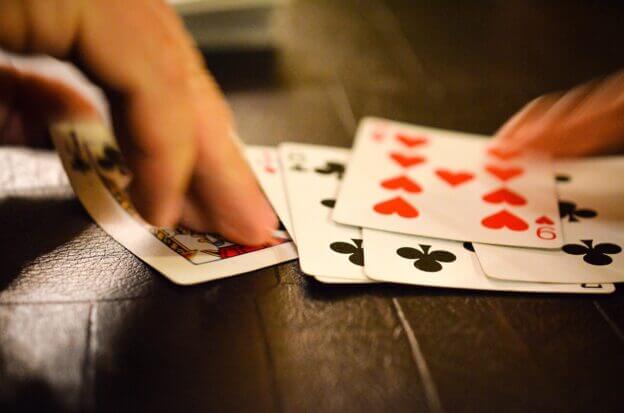Welcome to the rapidly expanding world of Double Board Bomb Pots, a thrilling new PLO format that’s taking the live poker scene and online platforms by storm. Double-board bomb pots represent a relative departure from traditional PLO strategy, and its rising popularity brings unique challenges and opportunities.
What are Double Board Bomb Pots?
The rules for a Double Board PLO Bomb Pot are simple. The basis of bomb pots in poker is that players skip the preflop betting round. Instead of posting the blinds, every player posts an ante, which is a forced bet of typically 3 to 10 big blinds. Everyone who posted the ante receives their hole cards, after which two separate flops are being dealt, and only here the first betting round starts.
In a double board format, two separate flops are revealed immediately after. The game then proceeds similarly to standard PLO rules but with a twist – each one of the two boards is followed by a turn and river.
At showdown, the pot is divided between the two boards, unless a single player holds the winning hand on both, in which case they scoop the entire pot. Should one player win one board and share the winning hand on another, a ¾ to ¼ split is possible and presents a frequent outcome for double board games.
In the following video from our Mastering Double Board Bomb Pots course, coach Georg Funke explains the basic setup and features for Double Board PLO Bomb Pots.
Double Board PLO Bomb Pot Strategy
In these early stages of the new format, many players rely on instinct rather than strategic analysis, often leading to costly mistakes. Common pitfalls include playing too conservatively or, more frequently, overcommitting with suboptimal hands. Additionally, a lack of positional awareness and a tendency to think in a linear fashion (“I have a set”) are evident in these games.
This article is designed to equip you with the necessary tools to sidestep these common errors and capitalize on the oversight of players who haven’t yet grasped the nuances of this format. Let’s start by establishing three cardinal rules:
- Focus on High-Value Hands
In double board PLO bomb pots, prioritizing high-value hands (the nuts) is essential. - Engage with Both Boards
Aim to play hands that are strong on both boards. If you’re weak on one, ensure you have compelling reasons to continue on the other. - Position is King
Positional awareness is even more critical than in other poker variants. Exercise caution, especially in early positions.
These foundational principles will help you get a better feel for the game format, for a deeper exploration into the strategies necessary for success.
Get ahead of the curve and become the best Double Board Bomb Pots player at your table. Check out our Mastering Double Board Bomb Pots course!
Double Board PLO Bomb Pots tends to be a straightforward game; a check often signals weakness, offering an opportunity to take control with aggressive play or to realize equity without fear of raises due to potential turn or river changes. When contemplating bets, ask yourself these critical questions:
- Future Hand Strength
Assess the likelihood of your hand strengthening by the river. - Performance in Position
Evaluate how your hand fares in position against a single opponent. - Isolation Probability
Consider the chances of successfully moving the action to heads-up, ideally in position (IP).
Often, these considerations might lead to a more passive approach, but understanding when and how to deviate from this is key.
Absence of Ranges
Unlike traditional poker formats, double board PLO bomb pots does not adhere to conventional range-based play. Each player starts with a random hand, equalizing the probability of encountering sets and two pairs across various board ranks. This randomness challenges players to reassess their hand evaluation strategies, keeping an open mind towards all possible hand combinations.
Frequency-Based Approach
The fact that players have 100% ranges allows for exact calculations at the table. Asking yourself questions like these will make you a more competent player:
- How often is middle set the best hand?
- How likely is it that villain has a flush on each board?
- Do I have a profitable stack-off at an SPR of 3 if I assume that my opponents only continue with at least two pair on one board?
To internalize the most important frequencies more quickly, we provide a 4-card and 5-card frequency table in our Mastering Double Board Bomb Pots Course. This content is also essential for playing single board bomb pots.
Want to have a frequency table handy while studying or playing? Get your free copy of the 4-Card PLO Frequency Table for Double Board Bomb Pots—just sign up for our newsletter! Stay ahead of the game with exclusive insights and updates.
Board Interaction
Static & Dynamic Boards
The terms ‘static’ and ‘dynamic’ describe the likelihood of the nuts changing on subsequent cards. Static boards, where the current nuts are less likely to be overtaken, encourage aggressive play, while dynamic boards require a more cautious approach. For instance, holding the nuts on a static board and a strong draw on a dynamic board warrants an aggressive stance, posing difficult decisions for opponents.
A simplified guideline is: “The static board drives the action”. So even if you flop a nut hand on a dynamic board, it might be the best approach to pot-control and play defensively.
Another aspect that is heavily influenced by board textures is the value of hands that connected to each board, but in a non-nutted way. The key question that has to be asked here is: “If my opponent has a strong hand on one board, how likely is it that he will also be good on the second?” The most extreme example would be two monotone boards, where it is very unlikely to have a flush twice.
On other board combinations, hitting the first board actually makes it more likely that you also connected to the second.
The Art of Freerolling
Freerolling, a concept found in single board Hold’em or PLO, is crucial in double-board bomb pots. This occurs when you share a hand strength with an opponent but have additional draw chances.
For instance, when you hold the nut flush on the top board, and a set on the bottom board while your opponent has the straight. Here you can at worst chop the pot but have full house outs to scoop.
In this clip from our Mastering Double Board PLO Bomb Pots course, Georg uses an example to go into further detail.
Push & Pull Dynamics
In double board bomb pots, deciding whether to attract more players into the pot or push them out is key. This strategy varies depending on your hand’s strength and the game’s stage. Non-nut draws and medium-strength hands often benefit from reducing the field, while strong combo draws thrive in multiway pots. On the river, the push/pull approach should be based on your relative strength on each board, aiming either to claim the existing pot or increase your payout by drawing more players in.
Math & Odds
Double board bomb pots introduce unique scenarios requiring modified equity calculations. On the flop or turn, you must average the equities from each board to gauge your overall hand strength. For example, if you estimate 70% equity on the top board and 10% on the bottom, your overall equity would be 40%.
In this clip from our Mastering Double Board PLO Bomb Pots course, coach Georg Funke shows examples on how to calculate double board equities.
If you’re studying double-board bomb pots, make sure to check out our in-browser double board PLO equity calculator, a simple tool that automatically considers the dead cards and calculates the equities from each board, averaging them out for a result.
*Just remember to enable double board in the settings.
Understanding these fundamentals is essential for any player looking to navigate the complexities of Double Board PLO Bomb Pots successfully. This game variant not only tests your poker skills but also demands a refined approach to strategy, hand evaluation, and decision-making.
5-Card & 6-Card Double Board PLO Bomb Pots
While a lot of the main principles also apply to these variations, some adjustments have to be made, for example re-evaluating frequencies. With each additional hole card, it becomes more important to look at re-draws and playability on later streets.
You should get into the habit of critically evaluating how strong your current hand – even though it might be the nuts on the flop – will be on the turn and river. The Mastermind’s Double Board PLO Calculator works for 4, 5, and 6 card and is a valuable tool to understand how specific hands perform. Especially in 6 card, where you can run into some surprises.
Conclusion
To thrive in double board bomb pots, it’s crucial to adopt a more refined approach: be cautious with mediocre value hands, maintain a keen sense of positional strategy, and meticulously evaluate the significance of each card in your hand and on the board. In summary, mastering this format revolves around three core strategies:
- Focus on Runouts
Always consider potential future cards and how they can improve your hand. Anticipate the runouts to make more informed decisions. - Bet Thoughtfully
Don’t automatically bet just because your hand seems strong now. Assess how your hand might fare against possible future board developments. - Weigh All Options
Evaluate the merits of betting, checking, and other actions. Understand the strategic value of each move, not just betting based on current hand strength.
Adhering to these principles will help you navigate the unique challenges owith greater skill and confidence. To take your double board bomb pot strategy to the next level check out our Mastering Double Bomb Pots Course!





























